By
Pradip Kandel
Build Change,
Kathmandu, Nepal
1. ABSTRACT
In this paper, an overview of the advances in findings regarding the study of the self-healing mechanism in the bituminous binder with emphasis on its implicationin the durability of the asphaltic pavements is presented. The pavement losses itsstrength, durability and required level of performance due to fatigue failure of the asphaltic layers under the repeated cycles of traffic loading ,temperature extremities, environmental factors such as moisture, rainfall etc. The ‘’self-healing’’ of the pavements eliminates the premature ageing and failure of the pavements and hence reduces the need of the frequent and costly maintenance of the pavements lowering the life cycle cost, eliminates the obstruction in the smooth traffic flow due to maintenance and rehabilitation. The basic principle behind the self-healing is using the material property to detect the progressing damage and repair the damage(itself or by external intervention). Several projects were conducted in the TU Delft regarding bacterial healing of the concrete, fiber reinforced cementiousmaterials. Also, the practice such as mixing rejuvenator microcapsules in the mix, Induction heating (steel wool fiber mixed in bitumen).The self-healing of the pavements has yet not been fully understood and still under research. Many of the researches whetherit be by F. hammoum etal., by Feng Su et al., by Enieb et al.,Gracia et al. ,by Barrasa et. al. give several important understanding about the self-healing mechanism in the flexible asphalt pavements .This paper goes through the important researches, findings and gaps and shortcomings in them and publications till now regarding the aforementioned topic .
2.INTRODUCTION AND DISCUSSION:
2.1 Background
The design philosophy of the pavements in the recent literatures incorporates the service life, and desired performance level and reliability. Researchers are always looking forward to obtain the infrastructures with longer durability and longer ‘’maintenance free’’ performance with low repair cost, required performance. But as the system deteriorates below certain service level or performance, repair is needed. The American Road and Transportation Builders Association, ARTBA states that 40.9 Billion USD is the amount only federal Government alone dedicated for highway maintenance and upgradew.as in 2014.According to CDMSmith the costs are growing every year, growing exponentially as the system ages
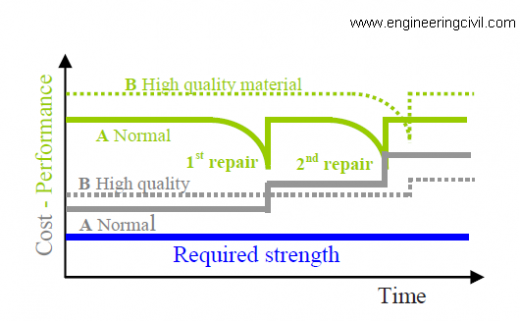
Figure 1: Performance and cost versus elapse time for normal and high quality materials (Van Breugel 2007).
Repair is needed as seen from the curve before the performance falls below a limit to bring it back to the same level of performance.
Moving to the subject of our concern, the several self-healing (where the material regains strength and stiffness, by itself or any external intervention) techniques has been tested upon several materials. Healing mechanisms are tested upon the Polymers (with encapsulations), concrete (with bacteria, hollow fiber, microencapsulation, expansive agents and admixtures), asphalts with nanoparticles, steel fibers (induction heating) or rejuvenator capsules. The use of this technique in the maintenance free, long-life pavement construction has been the matter of research and discussion and many attempts are made towards this till date.
2.2 Overview of the researches and findings
The principle underpinning this technology is that when micro cracks begin to form within the pavement, they encounter a microcapsule. The fracture energy at the cracktip will open the capsule, thereby releasing the rejuvenator. The rejuvenator then diffuses with the asphalt binder to seal the crack, preventing its further propagation hence healing the damage.
Schalngen and Jonkers from TU Delft in their paper state that the self-healing is not just and miracle but materials can be designed for it.
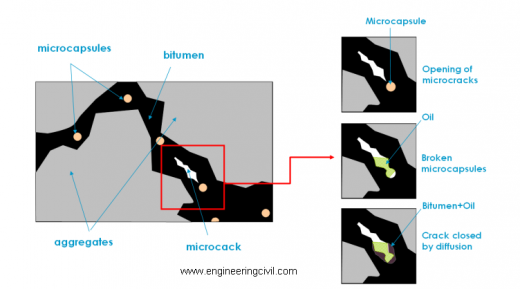
Figure 2: Schematic Representation of the working of microcapsule in asphalt.(Schlangen and Jonkers)
They postulate that although many literature explain about making of the capsules, the capsules have to endure the harsh condition to survive. To solve this, Capsules were made in the fine porous sand and covered with the composite of thermo-resistant resin and fine sand. The research are going to prove the efficiency for their working. Capsules are blended along with the whole mix throughout the depth .when the crack close to the capsule occurs, the capsule will break and the material diffuses and hence closes the cracks.
H. H. Noh, J. K. Lee (2012),used microcapsule containing self-healing agent endoDCPD(dicyclopentadiene) and fluorescent dye surrounded by MUF(melamine urea formaldehyde ) shell were synthesized and analyzed to develop self-healing coating system.Endo-DCPD-microcapsules have a significantly higher thermal stability than ENB-microcapsules according to their findings.
Hammoum and Stefani (2015) studied the cohesive failure of the bituminous binder and also the healing phenomenon of them .It describes the initiation and propagation of the crack in the binder .The cracks appear as the step in load vs. displacement curve in the study. He also showed that the healing of the material is the function of the temperature and the rest period allowed for the sample. The test used with the acoustic emission seems very promising to study the fracture and the healing mechanism.
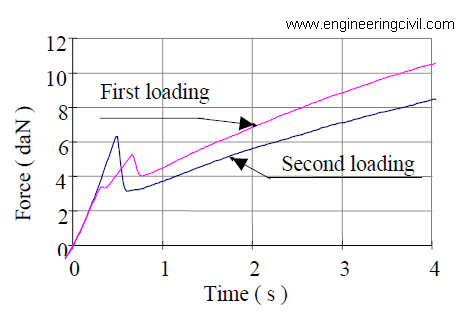
Figure 3: Local Fracture Test :Response of 50/70 bitumen at 0 centigrade after rest period of 4 hrs. (Hammoum 2015)
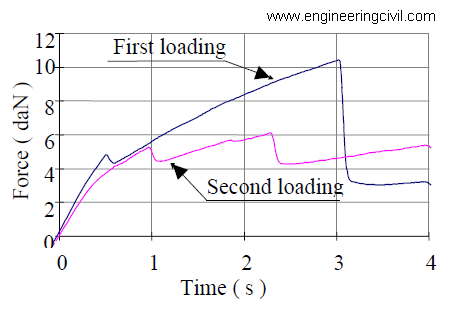
Figure 3: Local Fracture Test: Response of 50/70 bitumen at 0 centigrade after rest period of 2 Minutes. (Hammoum 2015)
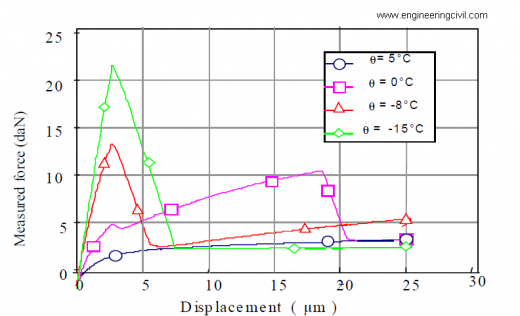
Figure 4: Temperature Effect on the response of 50/70 bitumen (Hammoum 2015), (Initial thickness 220 μm loading time 4 sec, max displacement 25µm)
Graphs show that the force drop, which could be related to the crack opening is more important at low temperature. It can disappear for the medium or relatively high temperature in the test conditions .Rest period of 4 hoursleads to the curve rather comparable to one from 1stloading. The nearly same slope of the curve before the drop in the 1st loading means nearly complete healing of the cracks unlike after second loading. Hencehe showed the result for logically the relation between healing with temperature and rest durations.
Feng Su and Peng Yang (2016), in their paper indicated that microcapsules can be easily broken by micro cracks generating and the rejuvenator can easily penetrate and distribute by capillary actions. The temperature and time greatly affects the healing process.
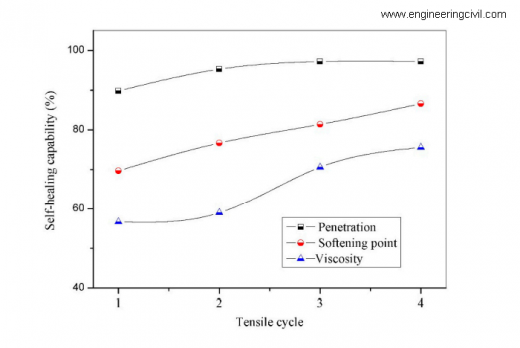
Figure 5:Self-healing capability of microcapsules/bitumen samples (microcapsules: 3.0 wt. %, 20 μm) calculated by properties values (during a reparative fracture-healing process (four recycles) under 0 °C, each cycle healing time of 24 h.(Feng Su and Peng Yang (2016).
By using the repetitive tension test, theself-healing mechanism was tested, microstructure of the bitumen/capsule was also analyzed and the tensile strength was recorded for evaluating the recovery efficiency of the aged bitumen.
The research by MahmowdEnieb, AboelKasim(2016 Dec ) put forward the approach of using the Nano-silica to increase the resilient modulus ,tensile strength ,fatigue life and to lower the moisture susceptibility to make the pavements more durable.
Several other attempts of research are also put forward by the different researchers or scholars from time to time ,which tried to understand the self-healing mechanism and to improve as well as quantify their efficiency.
Conclusion:
The current practice of using micro capsulation has several drawbacks till date. The challenge is to develop the self-automated process to assess the structure and material health and to trigger the response whenever necessary, multiple times in the service period. But now the multiple healing is not so much effective. The more research has to be done to trigger ‘’repair-on demand’’.Maybe, as stated in some literatures, the multiple healing can be achieved with the use of microcapsule of different shell thickness, size and ingredients. Some promising and cost effective alternatives of the capsule material is to be found out for its real life implication.The capsules blended with the asphalt have to endure the harsh condition to survive, they should resist the mixing process and should not react with the bitumen, also have to endure the compaction in the road at high temperature. A lot of research are needed to find the most effective and economical type of rejuvenator for capsules and commercial ways of production needed to be found out that they can be implanted in the field with low temperature diffusion and also be eco-friendly,
Still to optimize the actual size, shell and optimum quantity of the capsules needed in the mix, we need to develop mathematical model for simulating the release of materials form capsules. Still the mechanical and physical changes in the behavior of encapsulated asphalt are needed to be studied.Maybe some thermo-resistant shell are to be employed with more thickness but the problem may be that it may not break easily while needed to fill the micro cracks and may need external intervention making the process more cumbersome. Still many complication stand in quantifying the self-healing of the asphaltic concrete because assessing the self-healing by the strength is not a reliable approach. More viable options for micro capsulation materials are under research and we can expect them to be put forward in the next few years. The promising micro capsulation techniques will give us the less frequent and to less extent maintenance that lower the overall life cycle cost of the pavements. And of course we believe , ‘’self-healing is not just a miracle, butmaterials can be designed for it’’.
References:
1. “Self-healing of overloaded selfcompacting concrete of rigid pavement” , Khaled Z. Ramadan Rami H. Haddad
2. ‘’Two Ways of Closing Cracks on Asphalt Concrete Pavements: Microcapsules and Induction Heating’’, Alvaro Garcia Erik Schlangen, Martin van de Ven
3. ‘’Advanced self-healing asphalt composites in the pavement performance field: mechanisms at the nano level and new repairing methodologies’’. Agzenai Y, Pozuelo J, Sanz J, Perez I, Baselga
4. ‘’Addressing durability of asphalt concrete by self-healing mechanism’’ Raquel CasadoBarrasaa, Víctor Blanco Lópeza et al.
5. ‘’Self healing Technology for Asphalt pavements’’, Tabakovic and Schlangen,TU Delft.
6. ‘’Investigation of the Self-Healing Behaviors of Microcapsules/Bitumen Composites by a Repetitive Direct Tension Test’’, Jun-Feng Su,, Peng Yan
et al.
7. ‘’Experimental investigation of fracture and healing of bitumen at pseudo- contact of two aggregates’’ , F. Hammoum, C. de La Roche et al.
8. ‘’Recent Advances in the Self healing of Concrete”, Schlangen,Jonker et al.
We at engineeringcivil.com are thankful to Sir Pradip Kandel for submitting this paper to us. We are sure this would be very beneficial for engineers looking for more information on “Advances in Self-healing of bitumen by micro capsulation and its implications on durable Asphaltic Pavements”
If you have a query, you can ask a question here.


